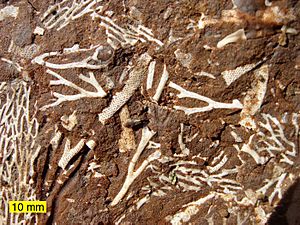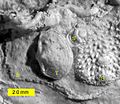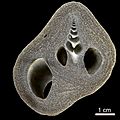Bryozoa facts for kids
Quick facts for kids Bryozoa |
|
|---|---|
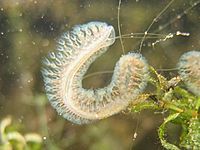 |
|
| A fresh water Bryozoan colony | |
| Scientific classification | |
| Kingdom: | |
| Superphylum: | |
| Phylum: |
Bryozoa
|
| Classes | |
|
Stenolaemata; Gymnolaemata; Phylactolaemata |
|
Bryozoans, also called Ectoprocta, are a group of small aquatic animals. They live together in large groups called colonies. These colonies often have a hard outer shell, or skeleton, made of calcium carbonate. This is the same material found in seashells.
Bryozoans have been around for a very long time. Their fossils show they first appeared in the Ordovician period. This was hundreds of millions of years ago! They live in a similar way to the polyps that build coral reefs. People sometimes call bryozoans "moss animals" or "sea mats" because of how they look.
Most bryozoans prefer warm, tropical waters, but you can find them all over the world. There are about 5,000 types of bryozoans alive today. Scientists have also found fossils of about 15,000 different types that lived in the past.
Each colony is made up of many tiny individuals called zooids. They are usually only about 0.2 millimeters long. These zooids create tubes around themselves. These tubes are often made of lime (calcium carbonate) or sometimes a tough material called chitin. All the zooids in a colony are clones. This means they are all genetically identical. They are made through asexual reproduction, where new zooids bud off from existing ones. Even though they are clones, many bryozoan species have different types of zooids. Each type has a special job.
All bryozoans have a special feeding part called a lophophore. This is a ring of about ten tentacles around their mouth. Each tentacle is covered with tiny hairs called cilia. When a zooid wants to eat, it pushes its lophophore out. The cilia on the tentacles beat to create a water current. This current pulls small food particles, like tiny algae, towards the zooid's mouth. When the zooid is resting or senses danger, it pulls its lophophore back inside its tube for protection.
Contents
Bryozoan Bodies
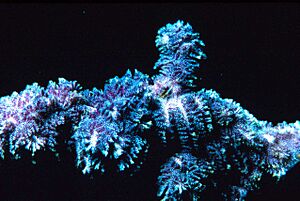
Bryozoan skeletons come in many different shapes. Some look like mounds, others like lacy fans, branching twigs, or even corkscrews. Their skeletons have many small openings. Each opening is the home for one zooid.
Inside their tiny bodies, zooids have a U-shaped gut. It has an opening for the mouth and another for the anus. They use their lophophore to catch food. The beating cilia on their tentacles create a water current. This current brings food, mostly tiny plankton, to their mouth. Some bryozoans even have a special stomach-like part called a gizzard.
Bryozoans are so small that they don't need a special breathing system or blood system. Gases like oxygen and nutrients can simply move in and out of their bodies. However, they do have a simple nervous system and muscles. These allow the zooid to quickly pull itself back into its shelter if it feels threatened.
One type of bryozoan, Bugula neritina, is interesting to scientists. It produces chemicals called bryostatins. Researchers are studying these chemicals to see if they can help fight cancer.
How Bryozoans Reproduce and Grow
Bryozoans can make new zooids in two ways: sexually and asexually. All bryozoans are hermaphrodites. This means each individual zooid has both male and female parts.
All the zooids in a colony are clones. They are all genetically the same. This happens through asexual reproduction. New zooids simply bud off from the first zooid. This is how a colony grows bigger. If a piece of a bryozoan colony breaks off, that piece can keep growing and start a whole new colony!
All the zooids in a colony are connected by thin strands of cells. In some bryozoan species, all the zooids are pretty much the same. They can all feed and sometimes reproduce. But in most species, the zooids have special jobs. The zooids that gather food are called autozooids. The zooids that don't feed are called heterozooids.
Heterozooids have different jobs. Some are for sexual reproduction, like developing eggs in special brooding chambers. Others are for protection, locomotion (moving around), or providing support for the colony. The jobs of some heterozooids are still a mystery!
When a species has zooids with different forms and jobs, it's called polymorphic. This means a group of genetically similar individuals develops into clearly different shapes and functions. Scientists are still learning about how bryozoans control these different forms.
Where Bryozoans Live
Most bryozoan species live in the ocean. But about 50 types live in freshwater. In their water homes, bryozoans attach to all kinds of hard surfaces. You can find them on sand grains, rocks, shells, wood, and even on boat hulls and pipes! Some bryozoan colonies don't attach to hard surfaces. Instead, they grow on soft sediment at the bottom.
While some bryozoans live in very deep water (over 8,000 meters!), most prefer shallower areas. Most bryozoans are sessile, meaning they stay in one place. But a few colonies can slowly creep around. There are even a few non-colonial bryozoans that live and move between sand grains. One amazing species floats freely in the Southern Ocean. You can also find bryozoan fossils in the Midwestern United States, especially in Ohio, Indiana, and Kentucky. This area was once covered by a large ocean.
Bryozoans eat tiny living things like diatoms and other single-celled algae. In turn, bigger animals like sea urchins and fish eat bryozoans.
Bryozoans almost always live in colonies. A single colony can have millions of individual zooids! These colonies can range from just a few millimeters to several meters in size. But remember, the individual zooids are tiny, usually less than a millimeter long. In each colony, different zooids have different jobs. Some zooids (autozooids) collect food for everyone. Others (heterozooids) depend on them. Some zooids, called kenozooids, help make the colony stronger. And others, called vibracula, help keep the colony clean. There is only one known bryozoan species, Monobryozoon ambulans, that lives alone and does not form colonies.
Bryozoan Fossils
The first bryozoan fossils appeared in the early Ordovician period. After that, they quickly became very common and diverse. They were a major group of fossils throughout the Palaeozoic era. They were an important part of the communities living on the seabed. Like modern bryozoans, they helped stabilize the sediment and provided food for other bottom-dwelling creatures. During the Lower Carboniferous period (about 354 to 323 million years ago), bryozoans were so common that their broken skeletons formed entire beds of limestone.
Almost all bryozoan species died out during the big Permian–Triassic extinction event. But they recovered well in the later Mesozoic era and became successful again. The fossil record shows more than 15,000 different types of bryozoans.
Most fossil bryozoans have skeletons made of minerals. The skeletons of individual zooids can be tube-shaped or box-shaped. They have an opening where the lophophore would stick out to feed. Most Ordovician bryozoans did not have pores in their skeletons. However, fossil evidence shows that the cell layers of zooids were connected from one zooid to the next.
A very important step in bryozoan evolution was when they developed hard, mineral skeletons and a way to push out their tentacles. The strong outer body walls protected them from predators. It also allowed for better connections between zooids and the growth of huge colony shapes.
Images for kids
-
Peronopora, a trepostome bryozoan from the Whitewater Formation (Upper Ordovician) of eastern Indiana, United States
-
Evactinopora bryozoan found in Jefferson County, Missouri, United States
-
An Upper Ordovician cobble with the edrioasteroid Cystaster stellatus and the thin branching cyclostome bryozoan Corynotrypa. Kope Formation, northern Kentucky, United States.
-
Ropalonaria venosa, an etching trace fossil of a Late Ordovician ctenostome bryozoan on a strophomenid brachiopod valve; Cincinnatian of southeastern Indiana, United States.
-
Phaenopora superba, a ptilodictyine bryozoan from the Silurian of Ohio, United States
-
The flat, branching bryozoan Sulcoretepora, from the Middle Devonian of Wisconsin, United States
See also
 In Spanish: Bryozoa para niños
In Spanish: Bryozoa para niños



